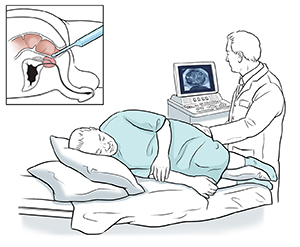Transrectal Ultrasound and Biopsy
A transrectal ultrasound (TRUS) is an imaging test. It uses sound waves and a computer to create pictures of the prostate gland for someone assigned male at birth. It doesn't use X-rays.
Your prostate gland is in front of your rectum. For TRUS, a special handheld probe (called a transducer) is put into your rectum to see your prostate. During this test, tissue samples (called a biopsy) may be taken out with a thin needle. A biopsy is used to diagnose cancer. This may be done if other tests, like a prostate-specific antigen (PSA) or a digital rectal exam (DRE), are abnormal.
TRUS is done by a specially trained technologist called a sonographer. It takes about 15 to 30 minutes. It might take longer if a biopsy is done during the TRUS by your healthcare provider (urologist). TRUS and biopsy can be done at your provider's office or an outpatient clinic.
Getting ready for your test
Here are some things that you might have to do before TRUS:
-
You may be asked to clear the poop from your bowel before the test. This may be done by putting liquid into your rectum (an enema). Or you may be asked to drink a special liquid to clean out your colon and rectum.
-
Follow any directions you're given for not eating or drinking before the test.
-
Tell your healthcare provider about any medicines, vitamins, herbs, or supplements you take. This includes any over-the-counter medicines, such as aspirin or ibuprofen. It also includes CBD, marijuana, or illegal drugs. You might need to stop taking some medicines, such as blood thinners, for 1 week or so before the test. Follow the instructions that your provider gives you.
-
You might need to start taking antibiotics before the test. This helps prevent infection.
-
Answer any questions your provider has about your health history. This will help tailor the test to your health needs.
During your test
-
You'll be asked to change into a hospital gown. You'll then lie on your side on an exam table, with your knees bent toward your chest. You will be awake during the test.
-
The test is done with a handheld probe. This is a short, slender rod about the size of your finger. It has a sterile, disposable cover on it. It's covered (lubricated) with gel. It's gently put inside your rectum.
-
You'll feel pressure from the probe. If it hurts, let your healthcare provider know.
-
Sound waves are sent into the probe and through the wall of your rectum. They bounce off your prostate. A computer uses them to form an image of the gland and nearby tissues. It can help find abnormal tissue in the prostate that may be cancer. This helps the provider know where to guide the needle to take out small samples of tissue for a biopsy.
-
If a biopsy is needed, you might be given medicine before the ultrasound to make you sleepy. Or you may be given a local anesthetic to numb the area. A biopsy is done using a small probe with a tiny hollow needle on the end. This needle very quickly goes through your rectum and into your prostate. It takes out small samples of the abnormal-looking tissue and tissue from different parts of the prostate. You might hear the click of the needle and it may sting or burn. Any pain from the biopsy is usually mild.
-
The samples are then sent to a lab to be checked under a microscope.

After your test
Before leaving, you may need to wait for a short time while the images are reviewed. If you had a biopsy and took medicine to make you sleepy, you may need to wait until it's worn off before you can go home. Arrange for someone to drive you home if you have received medicine. You may be given a thin pad to wear in case of bleeding.
In most cases, you can go back to your normal routine after the test. You may have some discomfort for a few days. It might be worse when sitting.
You might see some blood in your pee or poop for a day or so. A few weeks after the test you might see blood in your semen. This is normal. You may be asked to take antibiotics before and after TRUS if a biopsy is done. This is to help prevent infection.
Your healthcare provider will let you know when your test results are ready to review.
In some cases, a diagnosis can’t be made from the tissue sample that was taken. If this happens, your provider will talk with you about if you need another biopsy. Or you may need a different procedure.
When to call your healthcare provider
Call your healthcare provider if you have:
-
Very bloody pee or poop that seems to be increasing
-
A fever lasting 24 to 48 hours
-
Pain that's not getting better or that gets worse
-
Any other symptoms that your provider asks you to report, based on your health
Be sure you know what other problems you should watch for. Also know how to get help any time, including after office hours, on weekends, and on holidays.